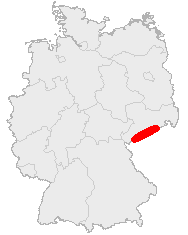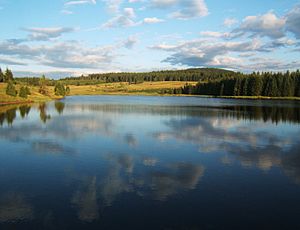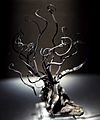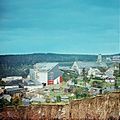Erzgebirge facts for kids
The Ore Mountains (called Erzgebirge in German and Krušné hory in Czech) are a mountain range located in Germany and the Czech Republic. These mountains form a natural border between the two countries for about 150 kilometers. They stretch from the western part of Saxony all the way to the Elbe river.
The Ore Mountains are well-known for their many special Christmas traditions. Long ago, people here mined for valuable ores like silver and tin. But when these metals became harder to find, the miners needed new ways to earn a living. So, they started making beautiful things by hand.
They became very skilled at lace making, weaving, and especially wood carving. Many famous Christmas decorations come from this region. These include nutcrackers, "smoking men" (little figures that hold incense), "pyramids" (carousels with figures from the Christmas story or mining scenes), and Schwibbogen (wooden arches with candles, which look like the entrance to a mine). The town of Seiffen in the Eastern Ore Mountains became a famous center for making wooden toys.
Contents
History of Mining and Crafts
The history of the Ore Mountains is deeply connected to mining. For centuries, people dug for valuable metals like silver and tin. This mining brought a lot of wealth and shaped the culture of the region.
From Mines to Workshops
When the mines started to run out of ore, the people living in the Ore Mountains had to find new jobs. They used their creativity and skills to start new industries. This led to the growth of traditional crafts that are still famous today.
Wood Carving and Toys
One of the most important new crafts was wood carving. People began to carve detailed figures and toys. This tradition is still very strong, especially in towns like Seiffen. The wooden toys and decorations from the Ore Mountains are loved all over the world.
Lace Making and Metalwork
Besides wood carving, bobbin lace making also became popular. Women would create intricate lace designs, which helped families earn money. The region also developed skills in metalworking, building on its mining past. Places like Frohnauer Hammer show how iron was worked into useful items.
Life in the Ore Mountains Today
Today, the Ore Mountains are a beautiful place to visit. They offer stunning natural landscapes and a rich cultural heritage.
Nature and Recreation
The mountains are a great place for outdoor activities. In winter, you can go skiing at resorts like Klínovec. In warmer months, there are many trails for hiking and exploring the forests and lakes. The region has unique natural areas and interesting rock formations.
Towns and Culture
Many towns in the Ore Mountains have a long history tied to mining and crafts. Annaberg-Buchholz is home to the impressive St. Anne's Church, which has an old mining altar. Boží Dar on the Czech side is actually the highest town in Central Europe. You can still see old mining tunnels and museums that tell the story of the region's past.
Christmas Traditions
The Christmas traditions are still a huge part of life here. During the holiday season, towns are decorated with the famous wooden figures and candle arches. Miners' parades, where people dress in traditional mining clothes, are also a special sight.
Images for kids
-
Replica open horse gin above the Rudolph Shaft (Rudolphschacht) in Lauta
-
The metalware factory of Louis Krauss, founded in 1887, in Schwarzenberg/Erzgeb. had developed by the time of German reunification into one of the most important production facilities for washing machines in Eastern Europe.
-
Annaberg-Buchholz, St. Anne's Church
-
Christmas in the Ore Mountains: candle arch with nutcracker and smoking figurines in Seiffen
-
Old adit near Johanngeorgenstadt
-
Karlovy Vary (Karlsbad in German, Carlsbad in English) is one of the most famous spas in the world. They are located below the Ore Mountains on the river Ohře
See also
 In Spanish: Montes Metálicos para niños
In Spanish: Montes Metálicos para niños





































